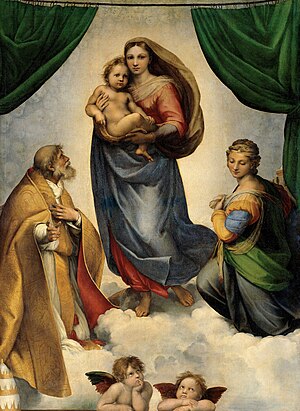Mary, mother of Jesus

Mary (Hebrew: מרים Mirjam; Aramaicܡܪܝܡ; Arabic مريم Maryam, Mariam, Meryem or Marjam; Greek: Μαριάμ Mariam), also called Madonna (Italian: "my lady") in artistic representation, is, according to the tradition of the New Testament and the w:Quran, the mother of Jesus of Nazareth, more precisely of the Nathanian Jesus. After her heavenly transfiguration, she is venerated as the Queen of Heaven (Latin: regina caeli or regina coeli) and is depicted in the Apocalypse of John in the image of the "woman clothed with the sun, and the moon under her feet, and upon her head a crown of twelve stars" (Rev 12:1ESV).
The Virgin Sophia
In esoteric Christianity, the mother of Jesus was always called the "Virgin Sophia", as also by John the Evangelist; only exoterically does he call her the "Mother of Jesus". In Christian esotericism, this refers to the astral body purified of lower sensual desires (→ catharsis) and elevated to the spiritual self. The fact that Mary's virginity must not be misunderstood as an external miracle in the bodily sense is also emphasised by the apocryphal Gospel of Philip, which belongs to the Valentinian gnosis:
„Some said, "Mary became pregnant by the Holy Spirit." They are in error. They do not know what they are saying. When has a woman ever become pregnant by a woman? Mary is the virgin whom no power stained. She is a great sanctuary for the Hebrews, that is the apostles and the disciples of the apostles. This virgin who stained no power, the powers stained themselves. And the Lord would not have said, "My Father who is in heaven," if He had not had another Father, but He would simply have said, "My Father!"“
The Two Jesus Boys and the Two Figures of Mary

Rudolf Steiner pointed out that at the begin of the Common Era not one but two Jesus boys were born, the Nathanian Jesus and the Solomonic Jesus. Accordingly, there were also two sets of parents. Rudolf Steiner states that the parents of both Jesus boys were called Joseph and Mary, which is not unusual, since these names were widespread in Palestine at that time. The figure commonly identified with Mary is the mother of the Nathanian Jesus boy whose birth story is described in the Gospel of Luke. The Nathanian Jesus, as is clear from the genealogical register of Luke's Gospel, came from the Nathanian line of the House of David. He descended to an earthly birth for the very first time at the dawning of the new age, but long before that he had a close relationship with the Christ in the spiritual world and prepared with Him through the preliminary stages to the Mystery of Golgotha His earthly incarnation, which only took place with the Jordan baptism in the 30th year of Jesus of Nazareth's life. The story of the second boy Jesus, the Solomonic Jesus, who descended from the Solomonic line of David, is described in the Gospel of Matthew. According to Rudolf Steiner, he was the reborn high Persian initiate Zarathustra.
Literature
- Rudolf Steiner, Catherine E. Creeger (Translator), Robert A. McDermott (Introduction): According to Luke: The Gospel of Compassion and Love Revealed. CW 114. Steiner Books 2001. ISBN 978-0880104883 rsarchive
- Rudolf Steiner: The Gospel of St. Luke. CW 114. Rudolf Steiner Press 1990. ISBN 978-0880102193 rsarchive
German
- Rudolf Steiner: Das Lukas-Evangelium, GA 114 (2001), ISBN 3-7274-1140-6 English: rsarchive.org German: pdf pdf(2) html mobi epub archive.org
 |
References to the work of Rudolf Steiner follow Rudolf Steiner's Collected Works (CW or GA), Rudolf Steiner Verlag, Dornach/Switzerland, unless otherwise stated.
Email: verlag@steinerverlag.com URL: www.steinerverlag.com. Index to the Complete Works of Rudolf Steiner - Aelzina Books A complete list by Volume Number and a full list of known English translations you may also find at Rudolf Steiner's Collected Works Rudolf Steiner Archive - The largest online collection of Rudolf Steiner's books, lectures and articles in English. Rudolf Steiner Audio - Recorded and Read by Dale Brunsvold steinerbooks.org - Anthroposophic Press Inc. (USA) Rudolf Steiner Handbook - Christian Karl's proven standard work for orientation in Rudolf Steiner's Collected Works for free download as PDF. |
